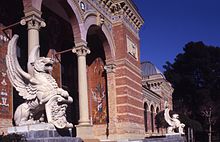Ricardo Velázquez Bosco
Ricardo Velázquez Bosco | |
|---|---|
 | |
| Born | 1843 |
| Died | August 1923 |
| Nationality | Spanish |
| Occupation | Architect |
| Buildings | Palacio de Cristal, Palacio de Velázquez, Palacio de Fomento, Pantheon of the Duchess of Sevillano |
Ricardo Velázquez Bosco (1843–1923) was a Spanish
Velázquez's most notable architecture was erected in
Biography

Born in 1843 in Burgos.[2] Use of
This building, which was constructed for the Exposición Nacional de Minería (1883), features ceramic tiles made by Daniel Zuloaga.[4][5]The Palacio de Velazquez and the nearby Palacio de Cristal are influenced by London's Crystal Palace. Velázquez taught the Spanish architect
He died in Madrid in August 1923.[2]
Archaeology and restoration
Velázquez, who from 1910 was the director of the Madrid school of architecture, also taught history of art. He was involved in archaeological and conservation projects, notably in the province of Córdoba, where he was assisted by the sculptor Mateo Inurria who was Director of the arts school of Cordoba.[7]
Archaeology
As an archaeologist, Ricardo Velázquez Basco was involved in the excavation of two
- Madīnat az-Zahrā (Umayyad Caliphs of Córdoba.[8]This long-abandoned site had previously yielded finds, but Velázquez' work effectively represented its rediscovery.
- Munyat al-Rummaniyya (El Cortijo Alamiriya). This excavation revealed the remains of a country estate with four rectangular terraces, over a 4 hectares (9.9 acres) area, of size 160 metres (520 ft) x150 metres (490 ft). Although the terraces are still to be seen, with the masonry of a pool in the upper terrace, the remains of a house which were examined by Velazquez are not longer extant. After analyzing the materials used in this structure he interpreted the site as an almunia with a layout found also at Madinat al-Zehrá.[3]
- After Velásquez' death the site was identified as Munyat al-Rummaniyya, an estate known from documentary sources.[9]
It has been suggested that there was a political motive for these excavations, as Spain was in the process of colonizing Morocco, a Muslim country; a process which culminated in 1912 when Spain and France made Morocco its “protectorate.”[10]
Restoration
Velázquez undertook restoration/conservation works at the
Works
His most important works include the following buildings in Madrid:
- 1881–1883: Pavilion for the National Mining Exhibition of 1883 at the Palacio de Velázquez, with engineer Alberto de Palacio and ceramist Daniel Zuloaga
- 1884–1893: School of Mining Engineering of Madrid
- 1887: Palacio de Cristal, with Alberto de Palacio and Daniel Zuloaga
- 1893–1897: Ministry of Agriculture
- 1898: National Association of the Deaf and Blind in Madrid, now houses the Centro Superior de Estudios de la Defensa Nacional
- 1917–1923: Ministry of Education
Some of his other works include:
- Reconstruction of the western facade of the Casón del Buen Retiro
- Gamazo Palace (Madrid)
- Mining Building Council (Madrid)
- 1905–1920: Blind and Deaf School in Santiago de Compostela
- Column commemorating the fourth centenary of the discovery of America, in Palos de la Frontera
- 1882–1916: Pantheon of the Duchess of Sevillano, in Guadalajara, with Daniel Zuloaga
References
- ^ ISBN 978-0-8263-3102-1. Retrieved 11 September 2012.
- ^ a b "Don Ricardo Velázquez Bosco" (PDF). Arquitectura. 5 (53): 281. September 1923.
- ^ ISBN 9789004162273. Retrieved 12 September 2012.
- ^ ISBN 9781119972587. Retrieved 12 September 2012.
- ISBN 978-84-86280-59-8. Retrieved 18 September 2012.
- ISBN 978-84-7491-706-2. Retrieved 12 September 2012.
- ^ Sajadian, Morteza (1984). Madinat al-Zahra and its sculptural decor, Volume 1. University of Wisconsin—Madison. p. 11. Retrieved 12 September 2012.
- ^ "Medina Azahara amplía su zona arqueológica". Archived from the original on January 17, 2013. Retrieved October 7, 2012.
- ^ "Al-Munyat al-Rummaniyya". Middle East Garden Traditions. 2007. Retrieved October 4, 2012.
- ISBN 9789004108721. Retrieved 12 September 2012.
- ISBN 9780415216951. Retrieved 12 September 2012.
